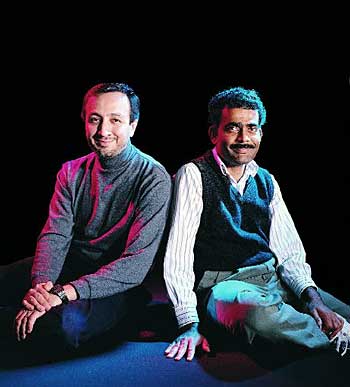engineering a better InternetCommunications"We will migrate from the workstations of today to a smart card that we will put in a variety of devices, and the user environment will come to us, wherever we happen to be."–J. J. García-LunaComputer engineers J. J. García-Luna and Anujan Varma (Photo: R. R. Jones)  According to Anujan Varma, a professor of computer engineering in UCSC's Jack Baskin School of Engineering, the technology already exists for the Internet to support a wide range of communications services at high levels of performance and reliability. The infrastructure needed to bring that performance and reliability into people's homes hasn't been built yet, but it's coming, Varma says. Telecommunications and networking companies are investing billions of dollars to improve their networks, replacing old copper wires with high-speed fiber-optic cables and upgrading other key components. Eventually, Varma predicts, telephone networks and the Internet will merge into one entity. "Sooner or later, we will be using the same network for both voice and data communication," he says. Most people who use the Internet remain blissfully ignorant of the complex physical infrastructure that brings Web pages and e-mail to their computer screens. The Internet is basically a diverse family of interconnected computer networks. Varma, who teaches an introductory course on the engineering behind the Internet, describes it in terms of two simple processes: Transmission, mostly over optical fiber, moves information from one place to another; and routing or switching gets things to the right place. Varma's specialty is high-speed switching--how to move packets of data rapidly from one transmission line to another. "It's a question of how to engineer the switches to support higher speeds," Varma says. "We don't need fundamentally new technology, just a lot of engineering work to make things faster and cheaper." Although private industry is the driving force behind most of the changes in communications, researchers like Varma and his colleagues in the School of Engineering are important players in this ongoing high-tech revolution, as consultants to and collaborators with industry and also as the educators of the high-tech workforce. Professor of computer engineering J. J. García-Luna, for example, is involved in a variety of projects designed to address the challenges raised by the explosive growth of the Internet. His Computer Communications Research Group is developing new ways to create wireless networks and to support videoconferencing and multimedia collaborations over the Internet. García-Luna envisions a future in which the Internet will essentially replace the personal computer. All of the computing power, data-storage capacity, and communications links one might want will be available over the Internet, and people will be able to access these resources from any number of devices, most of them wireless. Instead of a personal computer, says García-Luna, people will have an assortment of handy devices that connect to the Internet--at their desks, on the walls of classrooms and conference rooms, in their cars, and throughout their houses. "We will migrate from the workstations of today to a smart card that we will put in a variety of devices, and the user environment will come to us, wherever we happen to be," García-Luna says. Already, companies offer "smart" cell phones that can receive e-mail and provide limited access to the World Wide Web. García-Luna expects to see a proliferation of such "Internet-to-go" devices tailored to serve a variety of specialized purposes. Maybe we'll have little portable screens on our kitchen counters for displaying recipes and cooking videos culled from an Internet database. And that futuristic fantasy of the fifties, the videophone, may finally become as pervasive as the telephone through real-time transmission of audio and video over the Internet. Making all this possible will be a massive technological infrastructure operating behind the scenes. The Internet backbone will provide transmission services, while data processing and storage will be provided by "server farms," buildings full of supercomputers connected to the Internet. "The issues we face today are how to manage this new world," García-Luna says. One of the biggest concerns is security for computer networks and wireless communications, says García-Luna, who is developing secure protocols for wireless devices in a project sponsored by the Defense Advanced Research Projects Agency. Another major challenge is how to handle multimedia--combinations of data, graphics, audio, video, and so forth. Real-time transmission of multimedia over the Internet will require not only high-speed connections but also new transmission protocols and standards. Varma, García-Luna, and other UCSC researchers are involved in several projects relating to multimedia communications. "We already have a lot of the pieces we need to make these things happen," Varma says. "For the past 20 years, the work has been on developing the underlying technologies, but the challenge for the next 20 years is to make the best use of that technology." --Tim Stephens |